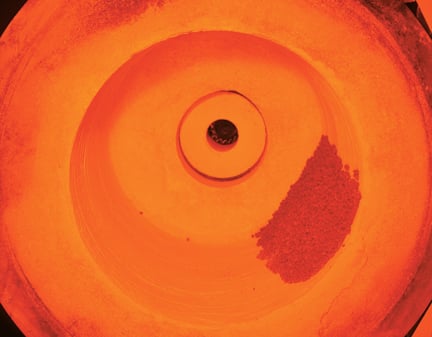Rotary kilns are used to process a wide variety of materials, causing a chemical reaction or phase change. Within the rotary kiln industry, there are two major subsets: direct-fired rotary kilns and indirect-fired rotary kilns. Both kinds of rotary kilns employ the same thermal processing principles, but operate differently and are therefore better suited to different applications.
The following information covers the similarities and differences between direct-fired and indirect-fired rotary kilns.
Direct-Fired Rotary Kilns
In a direct-fired rotary kiln, heat is pushed through the interior of the kiln, meaning the heat transfer comes from the direct contact between the heat source and the material. Due to the high heat being pushed through the kiln, this kind of rotary kiln is typically refractory lined, usually with a brick or castable lining, which protects the steel shell from the high internal temperatures.
This kind of rotary kiln is a robust and efficient unit for heat transfer and pyroprocessing. A common application for this type of rotary kiln is for metal recovery and waste combustion. One example of this is a direct kiln FEECO designed for nickel recovery from wastes. The wastes consisted of cellphones, batteries, etc. Inside the wastes was valuable nickel that could not be easily recovered.
FEECO designed a direct-fired rotary kiln that oxidized, or burned off, all of the organic material, leaving only the nickel and ash behind, which could be effectively recycled in the existing recovery units. In this case, a direct rotary kiln was the best choice where an economic and efficient heat transfer unit was required. However, in other cases where a controlled environment or enhanced process control are required, an indirect rotary kiln may be more appropriate.
Indirect-fired Kilns
An indirect rotary kiln, also commonly called a calciner, is a necessity when it comes to dealing with a material that cannot come into contact with combustion gases. An indirect kiln also offers superior temperature control along the length of the kiln.
In an indirect-fired rotary kiln, the heat is introduced to the outside of the drum shell via gas burners or electric heaters. In essence, the rotary kiln is rotating inside of a stationary housing. This avoids any direct contact between the heat source and the material. Because the heat is being transferred through the shell, an indirect rotary kiln is typically not lined in order to maximize the heat transference through the shell. Therefore, an indirect rotary kiln is usually made out of a temperature-resistant alloy, instead of carbon steel.
One of the major advantages to an indirect-fired rotary kiln is being able to tightly control the temperatures within the kiln by placing burners or heaters at strategic points along the outside of the kiln. This is useful in what is called a continuous kiln, where the material needs to be heated to a certain temperature to cause the desired chemical reaction, and then it has to be held there for a certain amount of time. In this case, burners would be concentrated at the beginning of the shell to heat the temperature up quickly, and then burners would be spread out for the remainder of the length of the shell, helping to maintain that constant internal temperature.
Another benefit of the indirect rotary kiln is that because gas is not mixing directly with the material, much less gas is released from the shell, therefore requiring much less treatment of the expelled gases.
Still yet another advantage of the indirect rotary kiln is the ability to control the internal process atmosphere. For example, in some cases it might be necessary to provide a nitrogen-rich environment for the material.
In some process situations, a combination of directly heated and indirectly heated rotary kilns is required. The direct-fired rotary kiln is used to burn off the organic fraction of the material being processed and further polishing of the resultant ash material is conducted in an indirectly heated kiln.
The choice of which rotary kiln is most efficient in certain applications depends solely on the needs of the material. Through our extensive thermal processing background, FEECO can take your thermal processing problems and develop a solution that works best for your unique process and material goals.
For more information on rotary kilns, contact us today!



